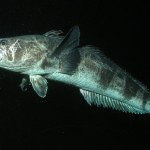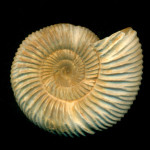New work in the Proceedings of the Yorkshire Geological Society indicates that ammonites were likely preyed upon beaked squids. The Chamouth Mudstone Formation on the British Coast is famous for its ammonite fauna from 183-195 million years ago. Twenty percent of the ammonites were found to have damage toward the rear of shell. This spot is the exact point that would allow for severing of the muscles that held the ammonite within its shell. Few predators would be capable of such a precise and adept kill. As the authors state
“The most likely predator was an active swimmer, able to hold and manipulate a smooth, possibly slippery, ammonite shell.”
The asymmetrical damage is consistent with a hard parrot-like beak. Sound familiar? Cephalopod kill shot!






The story is just a bit less exciting because we already know how it turns out – the coleoids win!
That’s interesting, though; some octopuses are known for very efficiently breaking/drilling bivalve shells to get the treats inside. Must be a pretty useful skill set in the ocean.